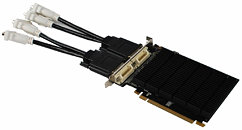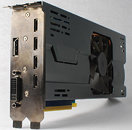- Joined
- Oct 9, 2007
- Messages
- 47,895 (7.38/day)
- Location
- Dublin, Ireland
| System Name | RBMK-1000 |
|---|---|
| Processor | AMD Ryzen 7 5700G |
| Motherboard | Gigabyte B550 AORUS Elite V2 |
| Cooling | DeepCool Gammax L240 V2 |
| Memory | 2x 16GB DDR4-3200 |
| Video Card(s) | Galax RTX 4070 Ti EX |
| Storage | Samsung 990 1TB |
| Display(s) | BenQ 1440p 60 Hz 27-inch |
| Case | Corsair Carbide 100R |
| Audio Device(s) | ASUS SupremeFX S1220A |
| Power Supply | Cooler Master MWE Gold 650W |
| Mouse | ASUS ROG Strix Impact |
| Keyboard | Gamdias Hermes E2 |
| Software | Windows 11 Pro |
Multi-display has huge benefits for productivity, gamers are only beginning to see them, but are restricted to higher-end graphics cards to get playable frame-rates. Prior to consumer multi-display ready graphics cards after ATI/AMD Eyefinity and NVIDIA 3DVision Surround, multi-display (>2 displays per graphics card) was restricted to the professional graphics market, where GPU vendors made a killing selling expensive graphics cards that handled over 2 display heads with just about enough graphics processing power to handle Windows Aero UI. One of NVIDIA's biggest AIC partners, Galaxy, took it upon itself to make GeForce-based multi-display graphics cards that make multi-display a lot more affordable. Currently, affordable multi-display graphics card market is dominated by AMD Radeon, where even the entry-level $50-something HD 6450 can handle 3 displays, while the $90-something HD 6670 handles 4.
Galaxy designed two new such GeForce-based graphics cards, the first is an entry-level card based on GeForce 210, which is single-slot, full-height, and silent. It uses two IDT VMM1402 chips to handle up to four full-HD (1920 x 1080) displays using four DVI connectors. The card has two DMS-59 connectors, there are two cables provided, which convert each DMS-59 to two DVI connectors.


The second card is more up to date in terms of connectivity. Based on the fast GeForce GTX 560 Ti GPU, the second card can drive up to 4 displays, with enough pixel-crunching power for 3D productivity apps such as CAD, modelling, etc. The card is more traditional Galaxy looking, with a blue PCB and spaceage cooler design. It uses a double-slot cooler with a hefty aluminum fin array, and a large fan to ventilate it. The card's connectivity includes one DVI, one full-sized HDMI, and four mini-HDMI. This card supports 3x 1680x1050 displays for a single 5040x1050 @ 60 Hz display-head, or 4x 1440x900 displays for a single 5760x900 @60 Hz display head. Galaxy will launch the two cards next month.
View at TechPowerUp Main Site
Galaxy designed two new such GeForce-based graphics cards, the first is an entry-level card based on GeForce 210, which is single-slot, full-height, and silent. It uses two IDT VMM1402 chips to handle up to four full-HD (1920 x 1080) displays using four DVI connectors. The card has two DMS-59 connectors, there are two cables provided, which convert each DMS-59 to two DVI connectors.


The second card is more up to date in terms of connectivity. Based on the fast GeForce GTX 560 Ti GPU, the second card can drive up to 4 displays, with enough pixel-crunching power for 3D productivity apps such as CAD, modelling, etc. The card is more traditional Galaxy looking, with a blue PCB and spaceage cooler design. It uses a double-slot cooler with a hefty aluminum fin array, and a large fan to ventilate it. The card's connectivity includes one DVI, one full-sized HDMI, and four mini-HDMI. This card supports 3x 1680x1050 displays for a single 5040x1050 @ 60 Hz display-head, or 4x 1440x900 displays for a single 5760x900 @60 Hz display head. Galaxy will launch the two cards next month.
View at TechPowerUp Main Site
Last edited by a moderator:


